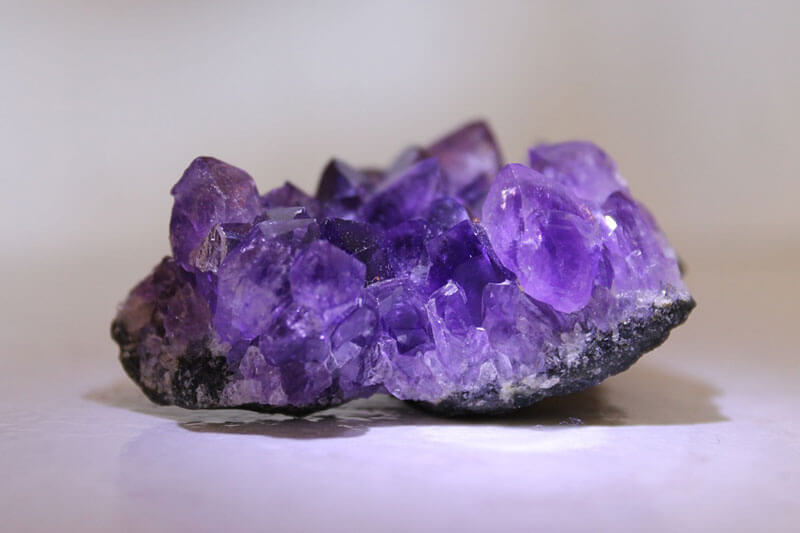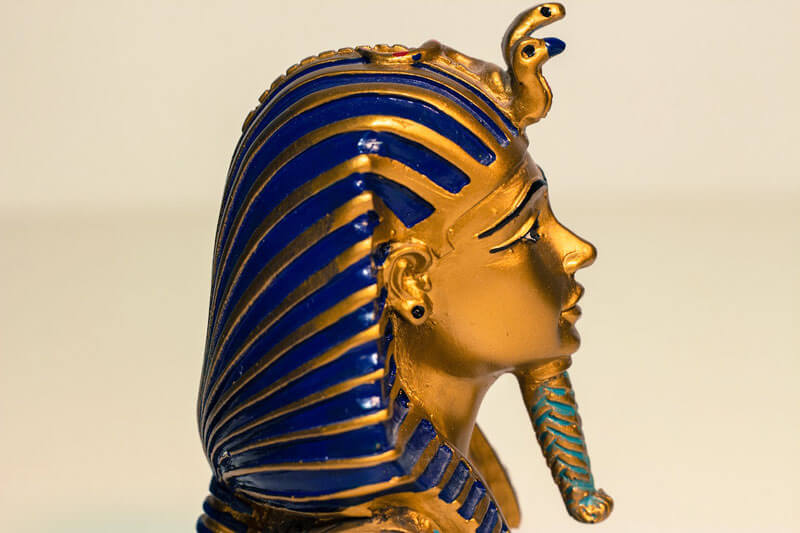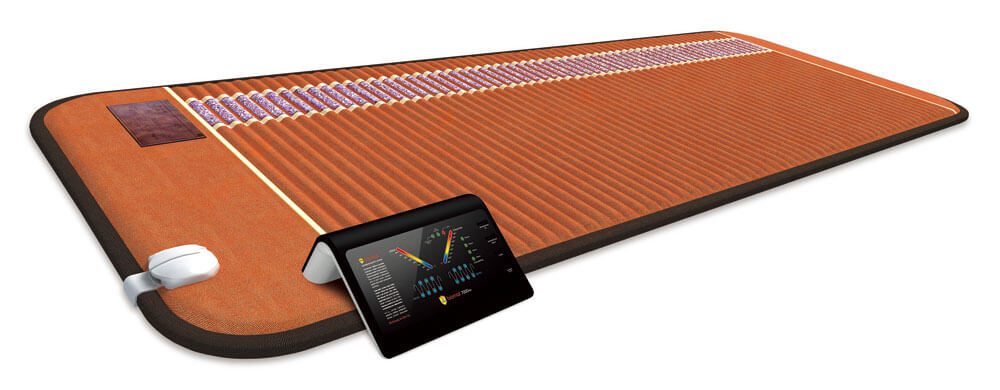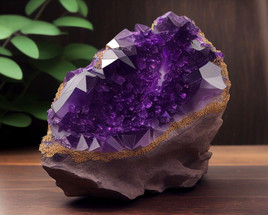Posted by Biomatstores.com on 16th Aug 2023
Amethyst and Its Contribution to the Amethyst Biomat
Learn all about amethyst, where it can be found, its history, and its history of healing. Learn about the science behind amethyst's healing abilities and how it generates far infrared rays. Amethyst has long been prized for its healing properties. It is believed to promote relaxation, reduce stress, relieve pain, and enhance spiritual growth. The Richway Amethyst Biomat takes these benefits to the next level by incorporating amethyst crystals into an infrared therapy mat that emits far infrared rays and negative ions.
What is Amethyst?
Amethyst is a beautiful purple variety of the quartz family, which is a mineral composed of silicon and oxygen atoms. It is one of the most popular and valuable gemstones due to its stunning color and abundance. The purple hue of amethyst is caused by the presence of iron impurities in the crystal structure. Amethyst is classified as a semiprecious stone.
Physical properties of amethyst: Chemically, purple amethyst is a type of macrocrystalline quartz, meaning it has visible crystals that can be seen without magnification. It has a chemical formula of SiO2, which means it is composed of silicon dioxide. The crystals of amethyst are formed through a combination of heat and pressure deep within the Earth's crust and are commonly found in cavities within volcanic rock. Amethysts form in long, prismatic crystals in geodes or hollow rocks.
The formation of amethyst begins when hot water containing silicon and oxygen ions flows through cavities and fractures in rocks. As the water cools, these ions combine to form a quartz purple crystal. The presence of iron impurities in the water gives the quartz crystals their distinct purple color. The intensity of the purple color can vary depending on the concentration of iron and other impurities present during the crystal's formation.

Where is the Best Amethyst Found?
South Korea is a notable source of high-quality amethyst, particularly in the Gyeongsangbuk-do province. The entire continent of South America has an enormous amount of amethyst but Brazil is one of the world's largest producers of amethyst and is known for its deep purple and vibrant-colored gemstones. The state of Rio Grande do Sul, in particular, is famous for its amethyst mines. Uruguay is known for producing amethyst of exceptional quality, with rich and intense purple hues. The country's amethyst mines, especially those in the Artigas region, yield beautiful specimens. Zambia is another country renowned for its high-quality amethyst. The gemstones from Zambia often exhibit a deep purple color with excellent clarity. Canada is known for its unique amethyst deposits, particularly in the Thunder Bay region of Ontario. Canadian amethyst is esteemed for its rich color and remarkable transparency. Russia has a long history of amethyst production, with notable deposits found in the Ural Mountains. Russian amethyst is highly regarded for its intense purple color and exceptional clarity.
It's important to note that amethyst can also be found in other countries such as Madagascar, Bolivia, and India, among others. The quality and characteristics of amethyst can vary within each country, so it's always recommended to assess individual gemstones based on their specific attributes.
The quality and value of amethyst are determined by factors such as color intensity, clarity, and size. Deep purple hues with minimal impurities are considered the most desirable and valuable.
History of Amethyst
Amethyst has a rich history that dates back thousands of years. It was highly esteemed in ancient civilizations and was considered a symbol of royalty and power. The name "amethyst" is derived from the Greek word "amethystos," which means "not drunken." This name originated from the belief that amethyst could protect its wearer from intoxication and drunkenness.
Amethyst has a rich history in Ancient Greece, dating back to the 8th century BC. The gemstone was highly valued and believed to possess powerful metaphysical properties. In Greek mythology, it was associated with the god Dionysus, the god of wine and revelry. The name "amethyst" itself is derived from the Greek word "amethystos," meaning "not drunk," as it was believed to prevent intoxication. Ancient Greeks would often wear amethyst jewelry and carve amethyst into goblets, believing that it would protect them from drunkenness. It was also considered a symbol of royalty and was frequently used in crowns and other regal jewelry.
Amethyst also held a special place in Ancient Rome. It was highly prized for its beauty and believed to possess mystical powers. The Romans, like the Greeks, believed that drinking from an amethyst goblet or wearing an amethyst necklace would protect them from intoxication and keep their minds clear. Amethyst was also associated with royalty and luxury, as it was often used to adorn crowns, jewelry, and amulets. The stone was believed to bring good fortune and ward off evil spirits. It was considered a symbol of wisdom, intelligence, and spirituality, making it a highly sought-after gemstone in Ancient Rome.
Ancient Egypt was no different when it came to assigning significance to amethyst, and like Rome and Greece, believed to possess metaphysical properties. Amethyst was associated with the goddess Hathor, who was revered as the goddess of love, beauty, and fertility. It was believed that wearing amethyst jewelry adorned the wearer with her divine qualities, bringing protection, healing, and spiritual enlightenment. It was also carved into amulets and placed in tombs to provide protection and aid in the journey to the afterlife. The Egyptians believed that amethyst had the power to ward off negative energies and evil spirits, making it an essential component in their funerary rituals. Furthermore, amethyst was used by priests and healers for its perceived healing energies. It was believed to alleviate pain, promote clarity of mind, and help with spiritual growth and meditation practices. Even in the afterlife, amethyst remained significant. It was incorporated into burial shrouds and placed alongside mummies, symbolizing eternity and providing spiritual guidance.

Amethyst's History in Healing
Amethyst has been used for its healing properties for centuries. It is believed to have a calming and soothing effect on the mind and body. Ancient civilizations used amethyst in various forms, such as amulets, to promote healing and spiritual growth.
In traditional Chinese medicine, amethyst is associated with the crown chakra, which is believed to be the center of spiritual consciousness. It is believed that amethyst can help balance and align this chakra, leading to a sense of calmness and mental clarity.
Amethyst is also believed to have the ability to purify and cleanse energy fields. It is often used in crystal healing practices to remove negative energy and promote emotional and spiritual healing. It is said to enhance spiritual awareness, intuition, and psychic abilities, as well as to ward off psychic attacks
The Science Behind the History of Healing with Amethyst
While the healing properties of amethyst have been believed in for centuries, the scientific explanation behind these claims is still being researched. Some theories suggest that the color of amethyst plays a role in its healing properties.
Purple is associated with calmness and spirituality, and it is believed that the color may have a psychological effect on individuals, promoting relaxation and reducing stress. This could explain why amethyst is often used for its calming properties.
Amethyst also contains trace elements such as iron and aluminum, which may contribute to its healing properties. These elements can interact with the body's electromagnetic field, promoting balance and harmony. The exact mechanisms behind these interactions are still being studied.
It has been proven that amethyst generated far infrared rays and that when amethyst is heated, these rays become exponentially stronger and longer.
Heating amethyst crystals enhances the production of far infrared rays due to a phenomenon called the thermoelectric effect. When amethyst is heated, it generates heat energy, which causes the release of far infrared rays. This process amplifies the strength and duration of the rays, providing enhanced therapeutic benefits for the body and promoting overall well-being.
Amethyst Emits Long Infrared Rays
Amethyst is a popular gemstone known for its stunning purple color. However, it also possesses unique properties that go beyond its aesthetic appeal. One fascinating characteristic of amethyst is its ability to emit long infrared rays, also known as far infrared rays (FIR).
Amethyst emits long infrared rays due to its atomic structure. It is composed of silicon dioxide, with traces of iron and other impurities. When heated, the iron impurities within the amethyst are activated. These activated iron ions vibrate at a specific frequency, causing the emission of long infrared rays.
Long infrared rays have a wavelength between 5.6 and 1000 micrometers, which falls within the electromagnetic spectrum of invisible light. These rays are often associated with various health benefits. When exposed to the human body, long infrared rays can penetrate deeply into the skin, reaching up to several centimeters below the surface.
The interaction between long infrared rays and the body's cells can have several positive effects. It can increase circulation, help to relieve pain and inflammation and stimulate the production of collagen and elastin, which are essential proteins for maintaining healthy skin. Additionally, long infrared rays can help relax muscles, reduce inflammation, and promote restful sleep.
When amethyst is heated, the emission of long infrared rays intensifies. The heat energy causes the activated iron ions to vibrate more vigorously, resulting in a higher level of infrared radiation. This increased emission can enhance the therapeutic effects of long infrared rays when using heated amethyst in various applications such as infrared saunas or heated amethyst mats like the Richway Amethyst Biomat.
The Richway Amethyst Biomat
Amethyst is incorporated into the Amethyst Biomat's construction in the third layer from the top in the Biomat's 17-layer construction. The amethyst crystals are evenly distributed inside channels that run horizontally down the entire face of the mat.
Some of the best amethyst crystals in the world are mined in South Korea, and this is where Richway owns its own mine and gets its high-quality amethyst from.
The Biomat heats the amethyst using a combination of electricity and far infrared rays. The mat is equipped with a patented heating process that generates heat when electricity is applied. This heat is then transferred to the amethyst crystals, super-charging the amethyst's natural ability to emit far infrared rays. The rays penetrate the human body up to 6-8 inches and vibrate at a frequency proven to have many health benefits. A controller made by Texas Instruments has temperature settings ranging from 95-158° F.
Amethyst enhances the far infrared heat generated by the Biomat. Far infrared rays are known for their ability to penetrate deeply into the body, promoting relaxation, pain relief, and improved circulation. The presence of amethyst crystals in the mat helps to intensify the effectiveness of the far infrared rays.
Amethyst Biomats only use high-quality natural amethyst.

The Differences Between Synthetic and Natural Amethyst
Synthetic amethyst is created in a laboratory using various methods, including heat treatment and irradiation, to mimic the natural formation of amethyst. It is often more affordable and can be produced in larger quantities. Natural amethyst, on the other hand, is formed naturally over millions of years and is prized for its unique color variations, proven health benefits and perceived metaphysical properties. Synthetic amethyst has absolutely no health benefits and can even be toxic when heated.
Biomat knockoffs using synthetic amethyst are imitation versions of the original Amethyst Biomat that claim to provide similar benefits while allowing for much lower prices. However, you get what you pay for. Synthetic amethyst lacks the natural energy and healing properties found in genuine natural amethyst, making it less effective in promoting relaxation, pain relief, and overall health. It is important to be cautious when purchasing such knockoffs and to choose the authentic Biomat for optimal health. The Amethyst Biomat provides natural infrared therapy that has many health benefits.
Health Benefits of the Amethyst Biomat
One of the Biomat's key benefits is its ability to relieve joint pain, including arthritis pain. The Biomat utilizes far infrared rays and negative ions, which penetrate deep into the body, promoting relaxation and reducing inflammation in the joints. This can provide much-needed relief to individuals suffering from chronic joint pain or arthritis.
In addition to alleviating joint pain, Amethyst Biomats is also effective in addressing back pain and minor muscle pain. The far infrared rays emitted by the Biomat penetrate the muscles, promoting relaxation and increasing blood flow. This can help to relieve tension and discomfort in the back and muscles, providing a natural and non-invasive solution of pain relief for the entire body.
Muscle spasms are another condition that can be effectively treated with the Amethyst Biomat. The gentle heat and infrared rays emitted by the Biomat help the relaxation of muscles, reducing spasms.
The Biomat's amethyst infrared heat therapy also improves blood circulation. The far infrared rays stimulate the production of nitric oxide, which dilates blood vessels and increases blood circulation. This increased circulation can have numerous benefits, including improved oxygen and nutrient delivery to cells, enhanced detoxification, and improved overall health.
The amethyst in Richway Biomats also emits negative ions, which help improve blood circulation, tissue oxygen, reduce stress and anxiety, and promote better deep sleep quality. Negative ion therapy also neutralizes harmful free radicals, improves respiratory function, and promotes overall well-being.
The Biomat is an FDA-approved medical device.

